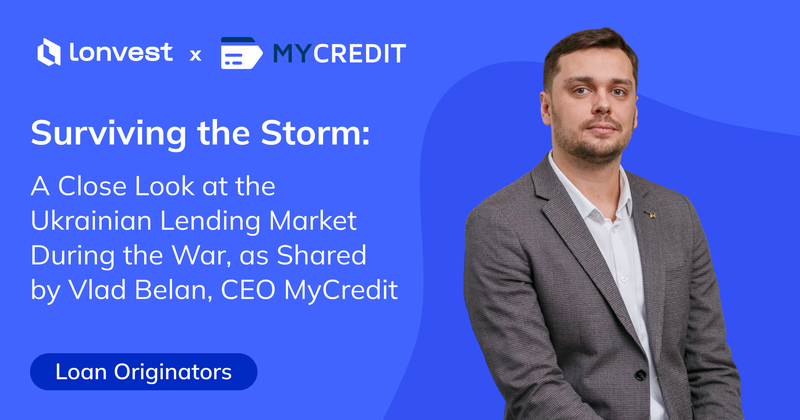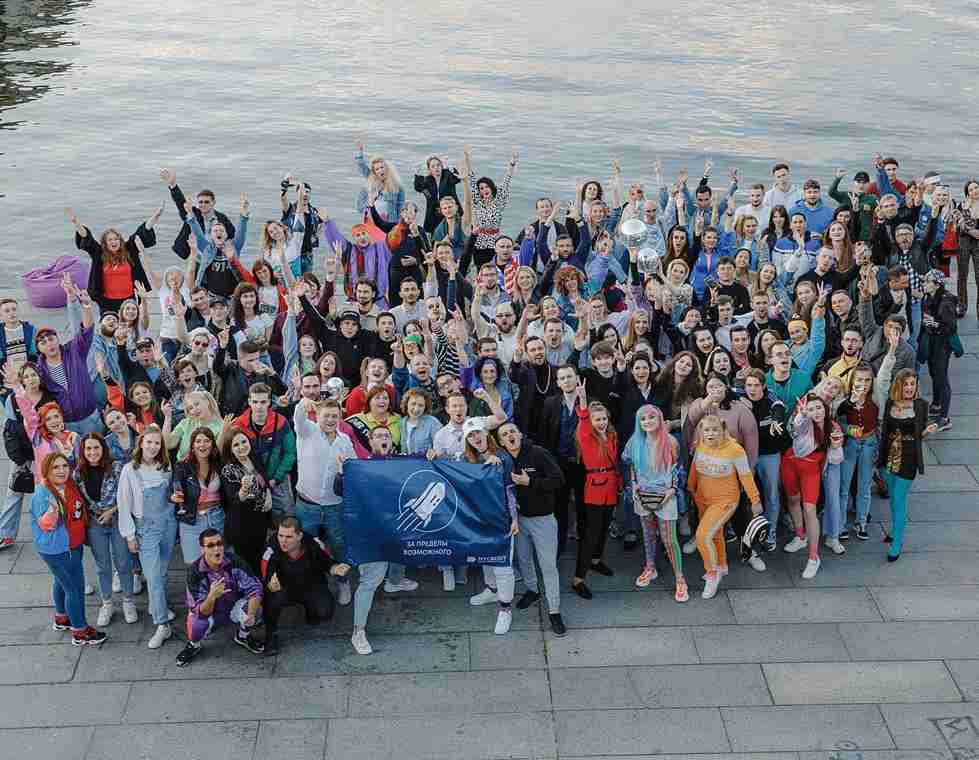A Close Look at the Ukrainian Lending Market During the War

Curious to explore the lending market in Ukraine, both from the beginning of the full-scale war and up to the present day, we had an insightful conversation with Vlad Belan, the CEO of MyCredit, one of the biggest Ukraine's lending company.
Although Lonvest doesn't currently offer investments in loans from Ukrainian companies due to the ongoing war and restrictions on foreign currency circulation by the National Bank of Ukraine (NBU), we remain optimistic. We believe that once the war ends and the NBU lifts these restrictions, the Ukrainian lending market will present an incredibly promising opportunity for European p2p investors.
Hi Vlad! Thank you for joining us today. We'd like to start by discussing the Ukrainian lending market and its recovery after the war. Can you provide some insights on how the market has been affected? Has the demand significantly decreased, and have the borrowing patterns of individuals changed as a result?
With the start of a full-scale invasion, the lending market in Ukraine completely stopped. Banks, one by one, removed card limits from customers, and companies issuing online loans ceased their activities.
The first thing we did at 4:00 am on 02/24, as soon as the first missiles arrived in Kyiv, was to stop the accrual of interest. We understood that it was wrong and unethical to charge interest in a country where the military phase was active.
Next, we focused on collection and working with overdue debts. As of February 24, 2022, our loan portfolio was approximately $30 million, and we understood collecting it back with interest in a real war was unrealistic. Therefore, using a marketing approach, we segmented the client database based on the amount that customers could pay.
We divided all clients into 3 segments:
-
1st segment – clients who can pay the principal of the loan,
-
2nd segment – clients who can pay half of the principal of the loan,
-
3rd segment – clients who can pay 10% of the principal of the loan.
For each of the segments, we performed simple calculations and offered the most lenient conditions for customers:
-
For those who could pay the principal of the loan, we wrote off all accrued interest. If you pay the principal, we close the loan.
-
For those who could pay half of the principal, we wrote off half of the accrued interest.
-
And for those who were ready to pay 10% of the principal, we offered a restructuring option, dividing the remaining principal into equal parts with a monthly payment schedule.
In addition, realizing that we would not be issuing new loans in the near future, we retrained the entire marketing department as collectors. We started utilizing their experience in attracting new customers to repay debts. The marketing team began using unconventional approaches and channels for debt collection, engaging with each client.
By demonstrating humanity and delivering a simple message, we not only retained client loyalty in a highly competitive market, even in war conditions, but we have also currently recovered 80% of the loan principal.
Having exhibited the right approach to clients and debt collection, we accumulated funds that we were ready to utilize for the resumption of operations. As soon as the russian tanks withdrew from the suburbs of Kyiv, we were prepared to resume lending.
On April 15, 2022, the company issued its first hundred loans during the wartime.
Of course, we had to halt activities in the temporarily occupied territories, as a significant proportion of our active target audience resides there.
Now there is a clear understanding that the income of the country's population has significantly decreased, and therefore MyCredit has lowered credit limits to reduce the debt burden on customers.
Clients have started requesting smaller amounts of money since they are primarily focused on meeting basic needs. The average loan amount has decreased as clients prioritize essential expenses, particularly for food, covering only a few days.
However, our bold approach continues to benefit us. For instance, we issued our first loan in the liberated city of Kherson on November 12, coinciding with the dates of the city's liberation by the Armed Forces of Ukraine. When you have access to sufficient internet and electricity for work, it becomes relatively straightforward.

How did the market shares of Lenders in Ukraine changed after February 24, 2022? Have market players changed their strategy?
Speaking about us, in our current scoring model, we began working with the top clients and improving individual assessments. For our initial customers, we disabled the auto-approve feature.
We also reevaluated our approach to lending to customers with overdue debts, and we concluded that refinancing is a normal practice.
We are gradually increasing the approval rate while closely monitoring default and recovery indicators.
According to our data, the volume of lending in Ukraine decreased by approximately 2 times. During this period, some companies exited the market and others did not resume lending.
Currently, our company holds the position of the market leader, ranking first in terms of the number of loans issued.
If we consider it in terms of groups of companies, we are in second place, following Aventus.
How does currency control and restrictions on the withdrawal of currency affect the work of companies? Previously, there were many companies with foreign investments or those who raised money in Europe on P2P sites.
As a partner of the biggest Ukrainian banking group – TAS Group, we never had the need to attract funds.
In 2021, we issued Bonds and actively expanded using these financial instruments. Now we want to diversify funding sources, so we intend to offer to invest in our group loans (Asia and Poland markets) with peer-to-peer lending platform called Lonvest.
There are rumors that the national bank is preparing to regulate the market and impose limitations on interest rates. How will this impact the market, and will companies be able to survive? What new challenges are companies preparing for in terms of National Bank of Ukraine regulation?
The primary proposal from the National Bank of Ukraine is to limit the maximum interest rates on consumer loans to 0.8% per day.
In reality, opinions on the new law are mixed. On one hand, the idea is good, and the goal is fair as it aims to reduce the financial burden on clients and filter out those who are least capable of repaying loans, which can become an unbearable burden. On the other hand, this project requires significant improvement. If it is accepted in its current form, the consequences could be catastrophic. MFIs (Microfinance Institutions) would simply disappear as a type of financial service.
It is disappointing that this project was not yet discussed with the market players. There are no economically sound studies supporting the need to reduce the daily interest rate. There is no evidence that the credit assessment currently conducted by lenders is ineffective.
Therefore, we believe that adopting this draft law in its current form is impossible. We have recently started discussions with the National bank of the draft law at the level of the Associations. We see the potential in creating an optimal law both for the lending market and for market players.
How do you see the prospects for the market after the war?
After Ukraine's victory, the market will gradually “Europeanize”. Laws and regulations will be implemented to align the Ukrainian product with European standards. This may involve both unfavorable changes, such as interest rate limitations, and favorable ones, such as the introduction of electronic courts.
Nevertheless, our business will continue to operate in a manner similar to how it currently functions in the European market.
What actions have helped your company survive since russia started full-scale invasion of Ukraine?
To begin with, I would like to emphasize the results we achieved at the beginning of 2022, until February 24. We managed to achieve a record result of 100,000 loans issued per month.
Behind this figure lies the hard work of our team, which has allowed us to firmly establish ourselves as leaders. We actively advertised on television, recognizing it as the largest platform in Ukraine in terms of coverage. Additionally, we formed partnerships with pop culture stars, understanding that moving forward, improvement is the only way.
And now, February 24th. Understanding of the world order collapsed. And the task of ensuring the safety of the team became the focus that did not let go crazy but helped to keep the purity of thinking and solve problems.
In the first week of the war, absolutely all our bond holders called us asking what our plans were. Then the market was in chaos, as it became obvious that customers were not ready to repay loans (which is understandable because people doubted the coming of tomorrow).
We decided that maintaining commitment to customers and partners is a key factor in the survival of the business. We need to be open and regularly inform them in a daily format about what is happening to us. The plan was simple – we do not refuse obligations and will do everything possible to keep the company.
Thus, we managed to solve an important challenge – the challenge of having bond obligations. You can be as efficient as you like, but when a company is in crisis, firstly, you have to pay your debts; such is the law of the market.
We were among the first to start lending because we believed it was the only way for us to survive. In other words, we needed to keep working and start generating income as quickly as possible. Let's start earning – there will be something to cover debts.
Let me remind you that this is against the background of the fact that out of 100,000 clients to whom we loaned money in January, only a little more than 10,000 have returned the money. However, this allowed us to distance ourselves from competitors in the market who were still in a frozen state. When you have a giant debt, it is not just a problem, but also an opportunity. :-) You need to act!
Next, we revised the strategy in terms of costs – we reduced literally everything that was possible as much as possible. Employees were aware of the situation because only through joint efforts could we overcome a critical situation. And so we sincerely informed everyone that we were starting everything from scratch: searching for clients, learning to sell without a marketing budget, building new risk models, and saving. The economy became our fixed idea until the moment of victory in the war. Today, we continue to save and spend about 15 times less on marketing than before February 24th. This is an important part of our antifragility, which we learned from the war.
When you have many resources, you may not be efficient, even though you can and want to be efficient. But when you are limited in resources, you focus on the main things, and it turns out that your efficiency grows. I believe that we will continue to cultivate this approach further, as limited resources give birth to real champions.
The risk we took turned out to be justified! By the end of last year, we became market leaders and finally emerged on top
MyCredit CEO Vlad Belan has been awarded the best lender СEO in Ukraine. What are the 3 reasons why this was achieved?
First, it is the well-coordinated work of the team. Each member understands the desired outcome of their work and their respective responsibilities. Additionally, our focus on results allows us to prioritize actions that are truly essential for the company's success.
Furthermore, I believe that setting clear and precise tasks for the team has contributed to our achievement. For instance, tasks such as 'increase the number of loans by X' make it easier to track and attain measurable results.

What are your product development plans for the next 6 months?
Currently, we are working with two brands – MyCredit and Click Credit. Both brands offer classic payday loans (PDL), with the only difference being in scoring models and client approaches. MyCredit has a stronger web presence and higher average loan amounts, while Click Credit utilizes a cheaper scoring model with a higher reliance on mobile device data.
Before the full-scale invasion, we had three additional types of lending products and brands: Monto, a PDL service targeting higher-risk clients, a loan tool service based on MyCredit with a two-month repayment period, and a new installment product called “Hummingbird” by BNPL.
Due to the active hostilities, we scaled back Monto and BNPL, focusing solely on PDL as it brings quick profits.
However, we are currently actively preparing to launch a credit line, similar to a card product but without an actual physical card, based on MyCredit.
Furthermore, we have plans to eventually issue a physical plastic card (as we did in Poland). However, this is a more distant prospect that is expected to materialize beyond the next six months.
I am very glad that our group of companies now has such a valuable asset as a Lonvest P2P platform that will allow us to develop even faster.

Lovinčićeva street, 3, Zagreb, Croatia
